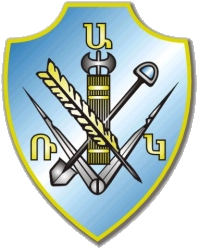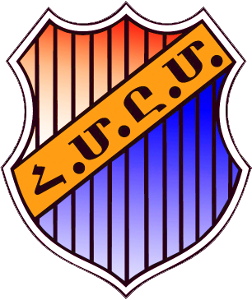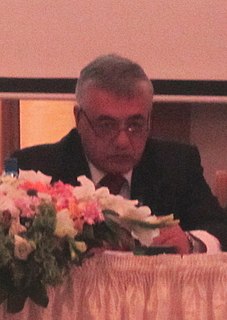Related Research Articles

The Armenian Revolutionary Federation also known as Dashnaktsutyun, is an Armenian nationalist and socialist political party founded in 1890 in Tiflis, Russian Empire by Christapor Mikaelian, Stepan Zorian, and Simon Zavarian. Today the party operates in Armenia, Artsakh, Lebanon, Iran and in countries where the Armenian diaspora is present. Although it has long been the most influential political party in the Armenian diaspora, it has a comparatively smaller presence in modern-day Armenia. As of December 2018 was represented in two national parliaments with three seats in the National Assembly of Artsakh and three seats in the Parliament of Lebanon as part of the March 8 Alliance. As of December 2020, the ARF has no seats in the National Assembly of Armenia.

The Social Democrat Hunchakian Party (SDHP), is the oldest continuously-operating Armenian political party, founded in 1887 by a group of students in Geneva, Switzerland. It was the first socialist party to operate in the Ottoman Empire and in Iran, then known as Persia. Among its founders were Avetis Nazarbekian, Mariam Vardanian, Gevorg Gharadjian, Ruben Khan-Azat, Christopher Ohanian, Gabriel Kafian and Manuel Manuelian. Its original goal was attaining Armenia's independence from the Ottoman Empire during the Armenian national liberation movement.
The Cedar Revolution or Independence Intifada was a chain of demonstrations in Lebanon triggered by the assassination of former Lebanese Prime Minister, Rafik Hariri. The popular movement was remarkable for its avoidance of violence, peaceful approach, and its total reliance on methods of civil resistance.

The Armenian Democratic Liberal Party, the Ramgavar Party,, also known by its Armenian initials or its English initials ADL is an Armenian political party in the Armenian diaspora including the Middle East, Europe, the Americas and Australia.
Articles related to or originating from Lebanon, including people, places, things, and concepts, are:

Martyrs' Square, historically known as "Al Burj" or "Place des Cannons", is the historical central public square of Beirut, Lebanon.

The Armenian Evangelical Central High School is one of the oldest and most-well established Armenian schools in Lebanon. It was founded in 1922 in a refugee camp, on the initiative of the Reverend Yenovk Hadidian. Ten years later, it moved to its present location in Ashrafieh, eastern Beirut.

Armenian Genocide Remembrance Day or Armenian Genocide Memorial Day is a public holiday in Armenia and the Republic of Artsakh and is observed by the Armenian diaspora on 24 April. It is held annually to commemorate the victims of the Armenian genocide of 1915. It was a series of massacres and starvation of 1.5 million Armenians by the Ottomans. In Yerevan, the capital of Armenia, hundreds of thousands of people walk to the Tsitsernakaberd Genocide Memorial to lay flowers at the eternal flame.
The Armenians in Lebanon are Lebanese citizens of Armenian descent. There has been an Armenian presence in Lebanon for centuries. According to Minority Rights Group International, there are 156,000 Armenians in Lebanon, around 4% of the population. Prior to the Lebanese Civil War, the number was higher, but the community lost a portion of its population to emigration. After surviving the Armenian genocide, and initially settling in shanty towns in Lebanon, the Armenian population gradually grew and expanded until Beirut became a center of Armenian culture. The Armenians became one of Lebanon’s most prominent and productive communities.

Bourj Hammoud is a town and municipality in Lebanon located north-east of the capital Beirut, in the Matn District, and is part of Greater Beirut. The town is heavily populated by Armenians.

The Armenian Genocide Martyrs Monument, better known as Montebello Genocide Memorial, is a monument in Montebello, California in the Los Angeles metropolitan area, dedicated to the victims of the Armenian genocide of 1915. The monument, opened in April 1968, is a tower of eight arches supported on 75-foot-tall (23 m) white concrete columns. The memorial was designed by Hrant Agbabian. It is the oldest and largest memorial in the United States dedicated to the Armenian Genocide victims. The inscription on the memorial plaque reads:
Armenian Martyrs Memorial Monument: This Monument erected by Americans of Armenian descent, is dedicated to the 1,500,000 Armenian victims of the Genocide perpetrated by the Turkish Government, 1915–1921, and to men of all nations who have fallen victim to crimes against humanity.
Martyrs' Day is an annual day observed by nations to salute the martyrdom of soldiers who lost their lives defending the sovereignty of the nation. The actual date may vary from one country to another. Here is a list of countries and Martyrs' Days.

Hampartsum Boyajian, also known by his noms de guerreMurad and sometimes Medzn Murad, was an Armenian fedayi and a leading political activist of the Hunchak party.
Hagop Kassarjian is a Lebanese politician of Armenian descent.

The Armenian Revolutionary Federation, also known simply as Tashnag, is an Armenian political party active in Lebanon since the 1920s as an official political party in the country after having started with small student cells in the late 1890s and early 20th century.

Homenetmen Beirut, or simply Homenetmen, is a football club based in Beirut, Lebanon, that competes in the Lebanese Third Division Group A. It is the association football branch of the larger Lebanese-Armenian multi-sports and scouting organization of the same name.

Yeghia (Yeghig) Jerejian is a Lebanese-Armenian author and political figure, Social Democrat Hunchakian Party Central Committee Member. From 1992 to 2009 he was elected as a member of the Lebanese parliament from Beirut.
The Bourj Hammoud electoral district or the Eight Constituency was an electoral district in Lebanon, used in the 1953 parliamentary election. The district elected a single Armenian Orthodox parliamentarian.
Artin Madoyan was a Lebanese-Armenian communist politician. He was the most prominent Armenian leader of the Lebanese Communist Party. He was seen as the 'right hand' of Syrian communist leader Khalid Bakdash.
Ayk was an Armenian daily newspaper published in Beirut Mondays to Fridays for the period 1953 to 1975. It was established by Dikran and Lucy Tosbat, as an independent non-partisan Armenian daily in stark contrast to the three other Lebanese Armenian dailies that were partisan and official party organs: Aztag, the organ of the Armenian Revolutionary Federation (Tashnag), Ararad, the organ of the Social Democrat Hunchakian Party (Hentchag) and Zartonk, the organ of the Armenian Democratic Liberal Party.
References
- 1 2 Le Paris des étrangers depuis 1945. Publications de la Sorbonne. 1 January 1994. p. 222. ISBN 978-2-85944-256-9.
- ↑ Zekâi Ökte; Tarihi Araştırmalar ve Dokumantasyon Merkezleri Kurma ve Geliştirme Vakfı (1989). Osmanlı arşivi: Yıldız tasnifi : ermeni meselesi. Historical Research Foundation/Istanbul Research Center. p. 20. ISBN 978-975-7555-01-8.
- 1 2 3 4 Messerlian, Zaven. Armenian Participation in the Lebanese Legislative Elections 1934–2009. Beirut: Haigazian University Press, 2014. pp. 260–263
- 1 2 3 4 5 6 7 8 9 10 11 The Armenian Review. Hairenik Association. 1975. pp. 94–95.
- 1 2 Yves Ternon (1983). La Cause arménienne. Éditions du Seuil. p. 193. ISBN 978-2-02-006455-2.